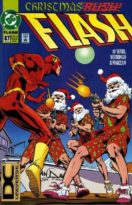X-Lapsed, Episode 049 – X-Men + Fantastic Four #3 (2020)
In today’s penultimate issue of X-Men + Fantastic Four, the stakes are upped once again! Well, sorta.
We’re going to talk a lot about how the X-Men are being portrayed here… and any time they’re pitted against, or sharing panel-space with, any other Marvel heroes. Your humble host tires of seeing his favorite folks “jobbed out” and made to look lesser-than every Marvel character from Willie Lumpkin on up!
We also talk a bit about Godpower… that is, if your host is understanding it right in the first place (please do not take a drink every time I say that…), and the fact that the Invisible Woman is THE MOST POWERFUL CHARACTER IN THE MARVEL UNIVERSE.
It’s a good time – and we’re just one episode away from the regular-sized, nothin’ happenin’, non-celebratory 50th Episode of this little program~! Thanks everybody!
—
@acecomics / @cosmictmill / weirdcomicshistory@gmail.com
chrisandreggie.podbean.com





I think I might have enjoyed this issue more than you did. A lot of this is probably down to any Speed Force parallels being lost on me. For financial reasons I had to greatly reduce my comics reading when I went to University in 1992 so I only read the first 6 issues of Mark Waid's run and missed the introduction of the speed force. By the time I tried Flash again it was being written by Geoff Johns and felt so changed that I've never gone back to Flash.
I quite like the god particle idea as it links to the old Official Handbook of the Marvel Universe. They always used to try to explain how powers work and often said their energies came from other dimensions. The one I see referenced most often is Cyclops. They said his eyes were a portal to a dimension of pure force. It's ludicrous but it's so memorable that it sticks with you.
Of course the ending of the original series revealed that Doom was deliberately setting the X-Men against the Fantastic Four so I'm expecting that kind of revelation in the final issue. It wouldn't surprise me if the block on Franklin's power ends up being generated by Doom.
As for Wolverine killing the person dressed as a Doombot, I think we're going to discover that he is brainwashing the mutants into Doombots. This would explain why thepeople who asked for help were against the X-Men. And if the Doombots are mutants they can be resurrected on Krakoa.
I'm looking forward to finding out when I read the next issue.
I was saddened that my revelation about Zdarsky inspiring the series and our favourite scene in HOX 1 seemed to knock the wind out of your sails. I think it's a positive. We know that Hickman tends towards big arcs with overarching storylines that stretch for years and years and he clearly has a plan in place. He knows what he wants to do but I think it's great to see that he is reacting to and incorporating ideas from other writers. He came up with the villainous old ladies by himself. In collaboration with Zdarsky he set up a fascinating status quo between the X-Men and the Fantastic Four. On that basis I'd rather see him collaborating than working solo.
You also say you wish we could go back to the Shooter years where continuity was cohesive and sacrosanct. There's actually a story featuring the same characters that denies that. In Uncanny 145-147 there is a story where Dr Doom and Arcade team up to kidnap the X-Men. The story only works with it being the real Doom because you see his thoughts about Storm which couldn't happen with a Doombot. John Byrne had left the X-Men just before this storyline and his first issue of Fantastic Four came out the same month as the end of the X-Men story. As soon as possible Byrne revealed that it was a Doombot in the X-Men story solely as a dig at Claremont. It's probably unsurprising that the 1987 F4/X-Men series started after Byrne went to DC.
There were other cases of writers changing continuity because they didn't like another writer (Bill Mantlo on the Hulk wrote out Doug Moench's run). I think sometimes we romanticise older comics but people were frequently changing things for reasons good and bad and most of the strong continuity was only within smaller groups of titles.